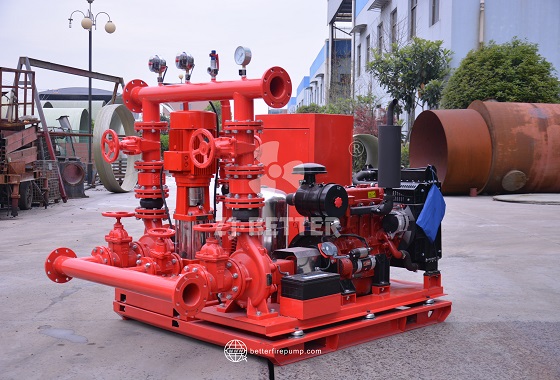In modern fire safety systems, a continuous and stable water supply is crucial for successful firefighting. However, fires are often accompanied by power outages, especially in high-rise buildings, warehouses, logistics centers, and industrial plants. Losing power can paralyze traditional electric pump systems, posing serious risks. The autonomous fire pump system, with its independent diesel power unit, eliminates the need for municipal power and provides uninterrupted water pressure support at critical moments, bringing greater reliability and assurance to the firefighting system.
1. Independent Power Supply, Eliminating Power Outage Risk
The key feature of the autonomous fire pump is its diesel engine as its core drive unit, completely independent of the external power grid. It can continue to operate even in the event of a city power outage or a building's internal power system failure. This advantage ensures that the firefighting system will not be interrupted by power outages during disasters or emergencies, significantly improving the success rate of fire emergency response.
2. Efficient Startup System, Ensuring Immediate Response
In the early stages of a fire, time is of the essence. The system, designed with an efficient startup module, can start and establish a stable water supply within seconds of receiving a fire signal. Compared to traditional electric pumps that rely on an electrical power source, autonomous power systems can respond instantly even in a complete power outage, ensuring rapid build-up of firefighting water pressure and effectively shortening rescue response time.
3. Powerful Power Output to Meet Various Scenario Needs
The autonomous fire pump's diesel engine boasts ample power reserves, capable of driving high-flow, high-lift pumps. Whether supplying water to risers within high-rise buildings or distributing water over long distances within large industrial plants, it can easily handle these requirements. Its robust power output ensures stable pressure and sufficient water volume, providing reliable support for a variety of complex fire scenarios.
4. Automated Control for Convenient Operation
Modern autonomous fire pump systems feature an intelligent control panel that enables automatic monitoring, switching, and operation. Manual user intervention is eliminated; the system automatically starts and operates upon receiving a fire alarm signal. Furthermore, the control system features real-time data monitoring, displaying key parameters such as water pressure, flow rate, and speed, enabling maintenance personnel to easily monitor operating status.
5. Stable and Reliable Structural Design
The system adopts a modular design, integrating the diesel engine, pump body, radiator, fuel system, and control cabinet onto a sturdy base. This structure ensures overall stability while facilitating transportation and installation. The base is shock-resistant, ensuring stability during extended operation and preventing vibration-induced failures or performance degradation.
6. Continuous Operation and Optimized Fuel System
The autonomous fire pump is equipped with a large-capacity fuel tank and supports extended continuous operation. The scientifically designed fuel system ensures stable combustion under high engine loads, preventing premature stalling. Furthermore, the optimized fuel consumption rate offers greater economic efficiency compared to traditional equipment, ensuring fire safety while reducing operating costs.
7. Adaptability to Complex Environments
At fire scenes, environmental conditions are often extremely complex, including high temperatures, smoke, dust, and even rainwater intrusion. The autonomous fire pump system was designed with this in mind, utilizing components that are heat-resistant, corrosion-resistant, and have a high degree of protection, ensuring stable operation in harsh environments. Whether installed outdoors or in underground machine rooms, it maintains excellent performance.
8. Application Advantages Across Multiple Industries and Scenarios
This system is widely applicable in locations such as petrochemical parks, storage and logistics centers, airports and terminals, power plants, hospitals, and high-rise buildings. The advantages of autonomous fire pumps are particularly evident in areas with relatively limited power supply. They can provide stable and reliable water supply to critical areas, making them an indispensable component of fire safety systems.
9. Easy Maintenance and Repair
To ensure long-term equipment reliability, the autonomous fire pumps were designed with easy maintenance in mind. The rational layout of key components and the strategically designed access ports allow maintenance personnel to quickly complete daily inspections and maintenance. Furthermore, the accompanying intelligent monitoring system provides real-time information on equipment operating status, providing early warning of potential problems and reducing failure rates.
10. Safety Standards and Certification Assurance
The autonomous fire pump system strictly adheres to international fire equipment standards and relevant testing specifications, and some models have obtained multiple authoritative certifications. This not only demonstrates reliable performance but also represents a high degree of safety assurance. This provides users with a more reassuring user experience while also meeting fire inspection and safety compliance requirements during project construction.
The autonomous fire pump system, with its independent energy supply, efficient startup, powerful power, and intelligent control, solves the critical problem of water supply interruptions caused by power outages during fires. It not only plays a vital role in fire safety in large buildings and industrial sites, but has also become an indispensable core component of modern firefighting systems. Choosing this system provides a higher level of safety for buildings and personnel.
